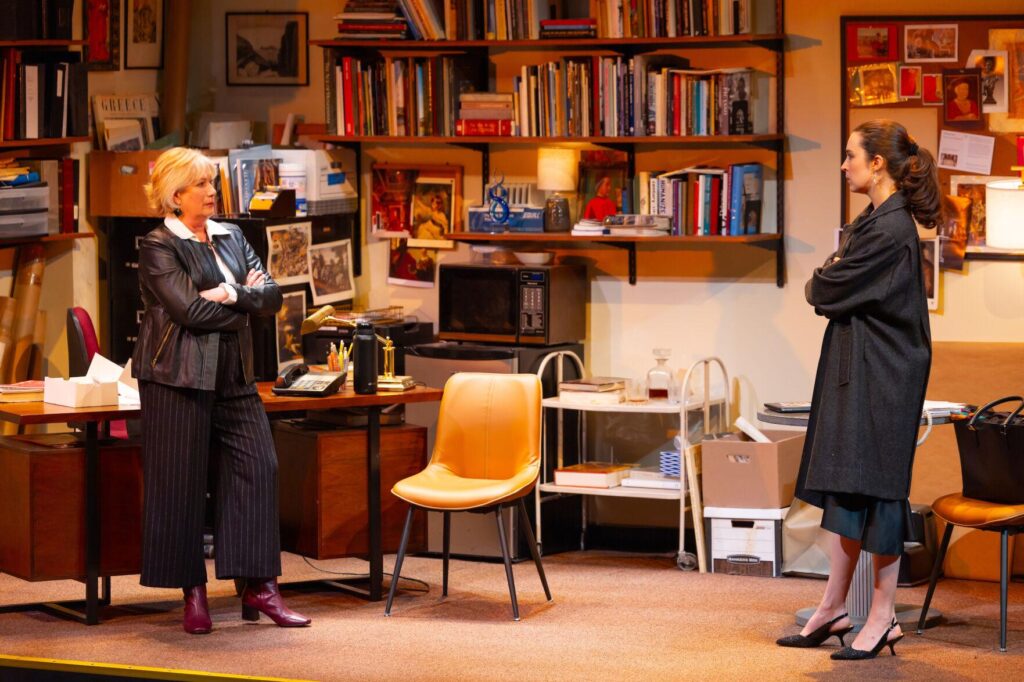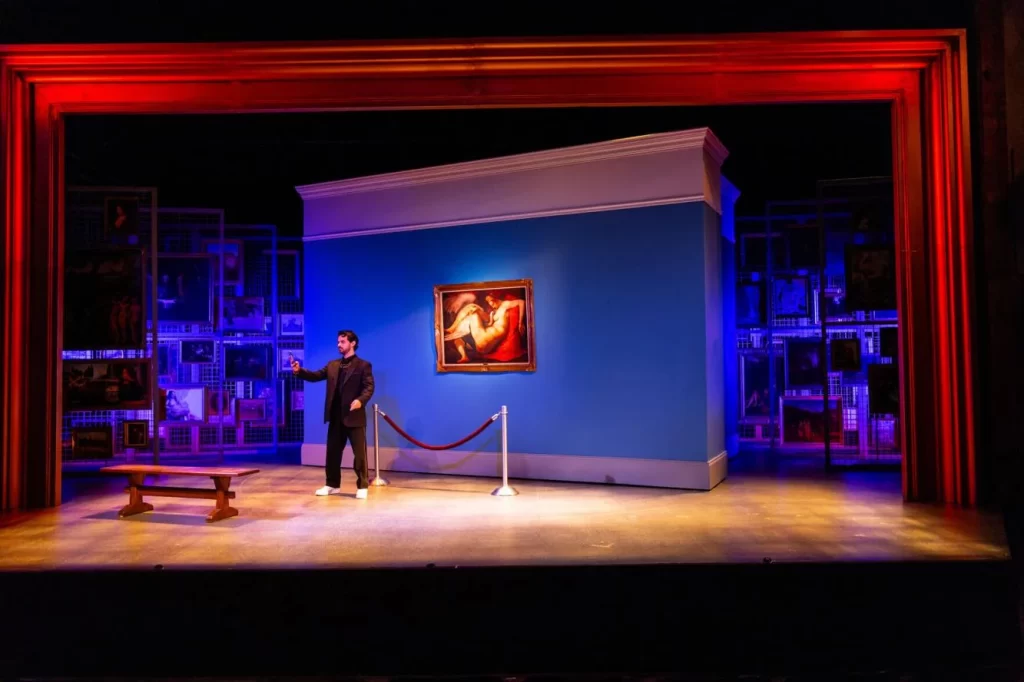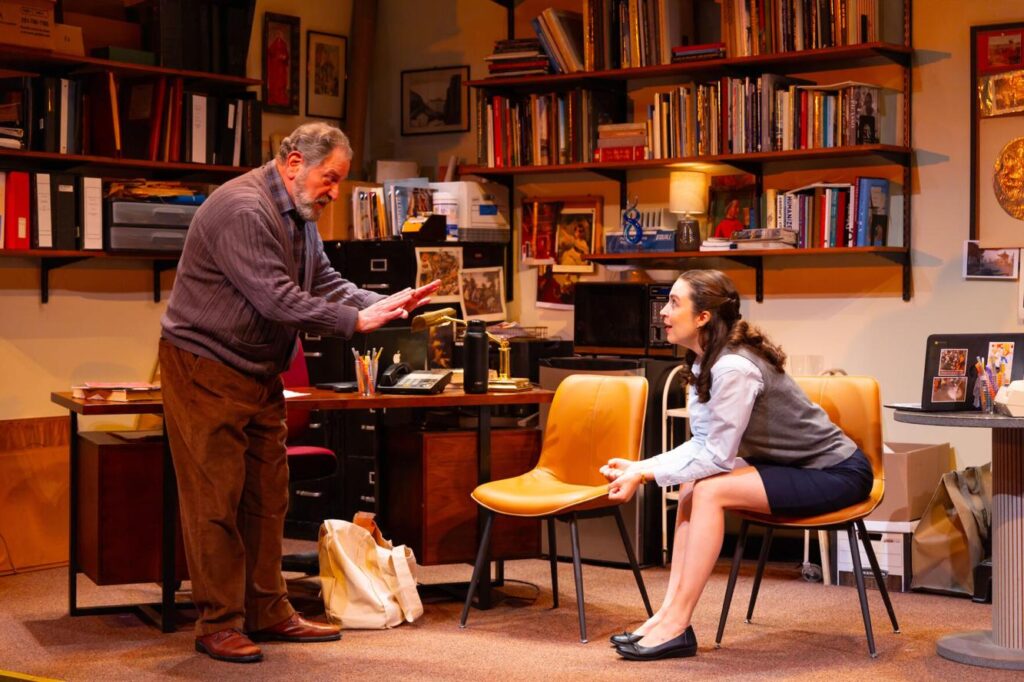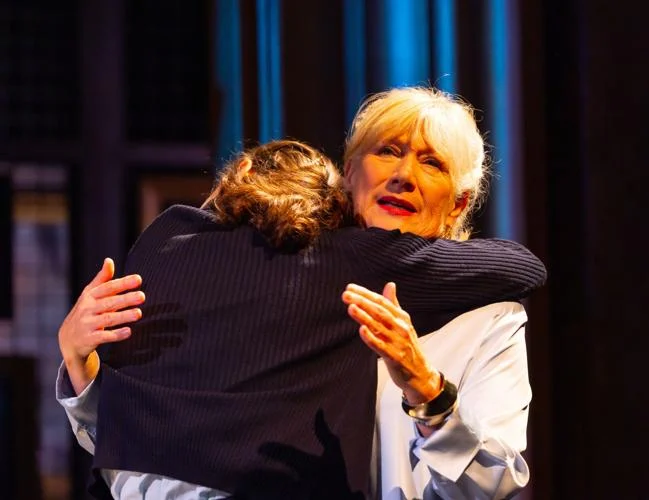
Photos by T Charles Erickson
“True Art” – Written by Jessica Provenz. Directed by Michelle Joyner. Scenic Design by Christopher and Justin Swader; Costume Design by Barbara A. Bell; Lighting Design by Patricia M. Nichols; Sound Design by Jane Shaw; Projection Design by Joey Moro. Presented by Dorset Theatre Festival, Dorset, Vermont. Run has ended.
By Shelley A. Sackett
It was good planning to arrive a little early for the Dorset Theatre Festival’s world première of “True Art.” The bewitching set begged a closer look. Center stage, basking in Renaissance splendor, is Michelangelo’s “Leda and the Swan,’ mounted on a rich burgundy panel. Stage left and right are mirror rows of vertical metal grids, each loaded top to bottom with the A-list of coveted museum possessions, from Pollack to Picasso and Monet to Miro.
These were very good replicas, so good in fact, that even up close, even knowing I was in a converted barn in Dorset, Vermont, and not on Museum Mile in New York City, for a split second, I felt like I was on hallowed artistic ground. Although stage prop replicas, these paintings could evoke the same kinds of feelings as the real McCoys.
Is that a bad thing? Is “fake art” valueless? Can only authentic art evoke valid feelings? Is an emotional reaction to counterfeit art necessarily counterfeit too?
It turns out one of the central questions playwright Jessica Provenz asks in her biting, suspenseful, thought-provoking, and funny newest play is in this same vein: In the provenance of the art world, what makes something — and someone — authentic? Is it the art or the artist? Is it what’s on the canvas or what the critics have written about its artist?

And, more importantly, how much does its history and reputation as an “important” work of art influence whether and how much we do — or feel we should — like it?
Provenz has a light touch and a gift for writing colloquial dialogue, so her play doesn’t bog down under the weight of these and other important issues she raises. What a gift to make your audience simultaneously laugh, gasp, and contemplate, which she does from the moment the play starts.
The action begins in media res at Christie’s auction house. Between the Swader’s set and Joey Moro’s projections, it is as if we are in the audience as auctioneer Buddy Silver (Bob Ari) coaxes higher and higher bids out of imaginary art collectors. On the block is “Leda and the Swam,” the lost Michelangelo painting recently discovered in a farmhouse somewhere in France.
The painting sets a new record for the most ever paid for a work of art.
The scene switches to a bench in front of a painting in a gallery at an iconic and prominent museum, where we meet 22-year-old Lauren Anders (a wonderfully talented Fiona Robberson), a Midwestern art history major and the new temp of Jodi Dean (the always fabulous Jayne Atkinson). Dean is the 60-something curator of Renaissance art and has a reputation for eating her interns alive. She averages one per month.

Enter J.J. Winchester (Charlie Reid), a flirty, slouchy young man around Lauren’s age who seems to have the keys that open every door in the museum yet has no articulable reason to be there. We get a lot of information from their casual and clever conversation.
Jodi, J.J. tells Lauren, is known as “Dragon Lady” and has had to claw her way to her position of power. She is the only woman being considered for the museum directorship and J.J.’s dad, the museum’s chairman of the board, is the lone holdout on her achieving this life-long goal.
The two are attracted to each other, and the actors bring an innocent carnality and spot-on delivery to their roles. Lauren tells J.J. she intends to become Jodi’s new intern. J.J. bets Lauren she won’t last the day as a temp.
As she scampers off to face the lion’s den, J.J., clearly smitten, gifts her with the tip that Jodi likes her coffee black, extra sweet.
The Swader’s marvelous set then swivels to reveal Jodi in her lair. Atkinson is perfect, playing Jodi as a gladiator and survivor who, from time to time, reveals emotions that surface through the chinks in her armor. She greets Lauren with daring and disdain. She immediately sets ground rules and lets Lauren know the lay of the land.
From the get-go, Lauren stands her ground while slyly taking the wind out of Jodi’s confrontational sails. She predicts and fulfills her desires (like coffee taken black with extra sugar) while pretending to defer, bow and scrape. Lauren is, after all, a Jodi wannabe. She is as determined and ambitious as her boss, willing to do what it takes to get where she wants to go.
Jodi is on her way to an important press conference. It turns out that Jodi and Buddy, Christie’s auctioneer, art dealer, and her sometime boyfriend, are the ones who found the lost Michelangelo masterpiece, “Leda and the Swan.” Her Renaissance department was the anonymous bidder that purchased it.
It also turns out that Lauren did her thesis on that very painting. She does not share her boss’s enthusiasm for the painting or the story of how it was miraculously discovered. Her challenge is to figure out how to navigate in a dangerous sea of deception and high stakes while maintaining her integrity and her job.
Against this thriller backdrop of smoke and mirrors, truth and lies, Provenz weaves a fabulous page-turner plot that examines two meaty topics. First is a deep look into what it takes for a woman to achieve power in a male world and the lengths she will go to retain it as she reaches the twilight of her career.
The second is the whole notion of authenticity, both in the art world and the world of everyday honor and decency. Do facts matter? Does the truth matter? Does getting it right matter as much as getting ahead?
A woman in power? Facts mattering? Timely indeed.

Director Michelle Joyner has an all-star cast to work with, and she milks their talent and Provenz’s script for all they’re worth. Atkinson, known on stage and television, has the chops to tap into both Jodi’s inner Dragon Lady and her insecurities with humor and humanity. Ari plays Buddy with equal parts smarm, charm, and menace. Reid is chameleon-like, understated and enigmatic one minute, and taking the helm and righting the ship the next.
But it is Robberson as Jodi’s protegée Lauren who really shines in every scene. She has a physicality of gesture and facial expression that dares the audience to look away from her. Hopefully, DTF theatergoers will see more of her next season.
“True Art” is chockful of great lines, high production value, and stellar performances, making it a theater lover’s trifecta of bounty. Yet it also leaves us with plenty to spark after-theater conversations, which are the measure of the most satisfying experience.
Jodi is at her rawest and most honest at the play’s end, when she looks herself in the eye, acknowledges the corners she cut and compromises she has made for the sake of her ambition, and wonders if it was worth it.
“What if my life’s work is wrong? What am I then?” she asks softly. What indeed.

